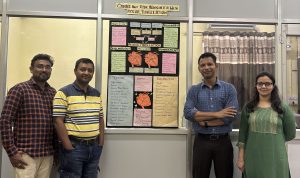NITR designs breakthrough upgrade to ECG

Rourkela: Researchers at the National Institute of Technology, Rourkela (NITR) have developed a breakthrough enhancement to electrocardiography (ECG), one of the most widely used techniques for monitoring heart activity. The new system enables clearer detection of subtle electrical signals from the heart’s upper chambers — signals that are often difficult to identify in standard ECG readings. These signals, specifically the P-waves, are crucial for diagnosing abnormal heart rhythms such as atria fibrillation, a condition that can significantly increase the risk of stroke. Atrial arrhythmias — irregular heart rhythms originating in the atria — are among the most common types of arrhythmia, particularly in hospitalised patients. Early detection is essential to initiate timely treatment and prevent complications. “P-waves are typically faint and often obscured by electrical noise or stronger signals from other heart regions,” said Dr J Sivaraman, lead researcher and assistant professor in the Department of Biotechnology and Medical Engineering at NIT Rourkela. “We introduced novel electrode placements that significantly increase the visibility of atrial activity in ECG readings. The improved signal clarity allows for quicker analysis and better clinical decision-making.” The research team developed a novel electrode configuration known as the Atrial Lead System (ALS).
In ECG diagnostics, “leads” refer to specific configurations of electrodes placed on the body to record the heart’s electrical activity. The ALS uses a modified lead arrangement to enhance atrial signal capture, especially improving the clarity of the P-wave. This innovation not only aids clinicians but also improves the performance of computer-based diagnostic tools. One of the most significant benefits of this system is that it does not require any modification to existing ECG machines. The innovation lies solely in how the electrodes are positioned, making it highly accessible for both public and private healthcare facilities without additional cost. Dr R Pradeep Kumar, senior interventional cardiologist at MIOT International, Chennai, emphasised the clinical importance of the system: “A clearly appreciated P-wave in the ECG provides vital clues in diagnosing atrial pathologies. To distinguish atrial fibrillation from other supraventricular arrhythmias, the morphology of the P-wave must be clearly interpreted.” The research team included Dr J Sivaraman, Dr N Bala Chakravarthy and Prof Kunal Pal, along with research scholars Prasanna Venkatesh and Arya Bhardwaj, all from NIT Rourkela.
Clinical validation and collaboration were provided by Dr Pradeep Kumar, also a visiting consultant at Jaiprakash Hospital and Research Centre, Rourkela. Their fi ndings have been published in international journals including Biomedical Signal Processing & Control, Medical Hypotheses, and Physical & Engineering Sciences in Medicine. A patent application for the Atrial Lead System (Application No. 202431094709) has also been filed. The project is supported by funding from the Anusandhan National Research Foundation (ANRF), Government of India. This collaborative achievement by NIT Rourkela, MIOT International, Chennai, and Jaiprakash Hospital, Rourkela, reflects the power of academia-clinical synergy and represents a major step forward in improving cardiac diagnostics and patient care in India and globally
News